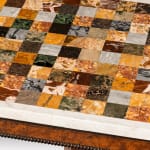Royal Regency Rectangular Amboyna and Ebony Pedestal Table with Specimen Marble Top
73 x 67.5 x 44.5 cm
Further images
Provenance
Supplied to King George IV at Windsor Castle – appears in the 1866 inventory for Room 233; no. 34. Gifted to Major Sir Owen Frederick Morshead in 1958. By descent.The rectangular marble top inlaid with antique marble specimens. Mounted on a rectangular table top made from amboyna wood, with split bobbin-turned ebonised moulding along the bottom of the frieze. Supported on a tapered octagonal pedestal with ebonised quadrant moulding at the base. With splayed quatrefoil legs decorated with split bobbin-turned ebonised moulding, terminating in a scroll foot raised on castors.
The underside of the table top branded ‘R 229’; the underside of the foot branded ‘VR’ beneath a crown, with the words: ‘1866 WINDSOR CASTLE ROOM 233’. Room 233 was a Bedroom – one of the new Private Apartments at Windsor Castle designed under the direction of the architect Sir Jeffry Wyatville. Room 229 was also a Bedroom – a blue room.
The following inscription is written on the underside of the table top: ‘When in 1926 my father, Owen Marshead was appointed Royal Librarian at Windsor he went, with his bride, to a furnished house on the Castle Grounds while the Lord Chamberlain’s dept. stored for him his own bits & pieces. Over 30 years later in 1959 when my parents retired and had to buy & furnish a place of their own several of the pieces had been lost so by way of compensation the dept. let them keep several things they had been using in the Garden House including this amboyna wood marble topped table that I’ve known all my life & has now on the death of Mum come to me. Phoebe Woollcombe.’
Major Sir Owen Frederick Morshead: (28 September 1893 – 1 June 1977) was a British Army officer and librarian. In 1926 he was appointed as Royal Librarian at Windsor Castle, where he remained in post until 1958.
Morel & Seddon: The French cabinet-maker and upholsterer, Nicholas Morel (fl.1790–1830), had first worked for George IV when he was Prince of Wales, supplying furniture to Carlton House and the Royal Pavilion, Brighton in the 1790s. In July 1826 he was appointed to furnish the new royal apartments at Windsor Castle, which were then being remodelled by Sir Jeffry Wyatville. Morel dissolved his old partnership with Robert Hughes (fl. 1805–30) and, in 1827, went into business with George Seddon (1769–1857), whose well-established family firm was probably the only one large enough to cope with this immense commission.
Morel & Seddon were the principal suppliers of furniture and furnishings to George IV (1762–1830) during his extensive refurbishment at Windsor Castle, 1827–30. Their lavish interior decoration helped re-establish Windsor as both the principal seat of the British monarchy and the leading example of the national style. To achieve this, Morel & Seddon repurposed fine French and English eighteenth-century furniture from George IV’s previous residence, Carlton House, as well as supplying new pieces in styles ranging from late Empire to Gothic Revival.
In all, Morel & Seddon furnished 59 rooms at Windsor Castle. To plan how the king’s existing furniture would be re-used, the partners worked partly from a ‘Pictorial Inventory’ made up of 214 coloured drawings of objects made by the office of A.C. Pugin. Today, this forms an invaluable record of the furnishings at George IV’s previous residences. Morel & Seddon then drew up a series of ‘miniature designs’ for the king showing their intended schemes of curtains, upholstery and furniture. Most of the surviving designs are in the Royal Collection.
Morel & Seddon also supplied new furnishings for Windsor, ranging from armchairs, bookcases and cabinets to wall hangings and candelabra. In the process, they collaborated with some of the finest craftsmen and designers of the day, including the Parisian cabinet-maker F.H.G. Jacob-Desmalter and A.W.N. Pugin. After three years, the partners produced a bill for their work which came to £203,963 6s 8d – the largest sum ever devoted to a single furnishing scheme in this country. However, a Parliamentary Select Committee strongly criticised the way the commission had been supervised, and dramatically reduced the sum to be paid.
Today, most of the surviving furnishing designed or supplied by Morel & Seddon remains in its original setting at Windsor (https://www.royalcollection.org.uk/collection/people/morel-seddon#/type/creator).










